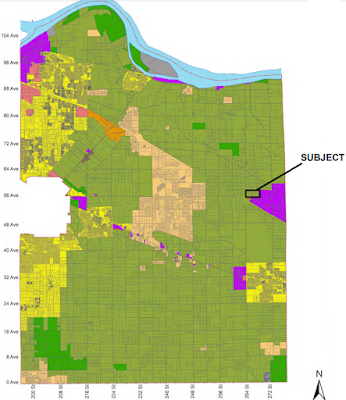The central tenet of the Metro Vancouver Regional Growth Strategy is to preserve rural, agricultural, conservation, and recreational lands. All municipalities in our region agree to this central tenet. Our region implements this central tenet through the Urban Containment Boundary.

|
| Metro Vancouver Urban Containment Boundary. Select the map to enlarge. |
Having an Urban Containment Boundary protects local food production, reduces greenhouse gas emissions and energy use from transportation, help sequesters carbon by maintaining greenspace, and encourages the co-location of housing, jobs, and services in walkable, bikeable, and transit-accessible neighbourhoods. For local governments, it also reduces the cost of providing services, meaning lower property taxes over the long term. The Urban Containment Boundary prevents sprawl.
Because of the importance of the Urban Containment Boundary, if a local government wants to adjust it, it requires the support of a two-thirds weighted vote of the Metro Vancouver Regional District Board (made up of representatives from Tsawwassen First Nation and all municipalities.) There are some exceptions.
Our region has an industrial land shortage. Industrial lands are important for our region. Point in case, while industrial land is only four percent of the region’s land base, over 25 percent of jobs are on industrial lands.
Industrial lands are also regionally designated and protected. Changing from industrial land use to another land use requires a 50%+1 weighted vote of the Metro Vancouver Regional District Board. This vote is a barrier to converting industrial land to other uses, though the barrier is lower than changing the Urban Containment Boundary.
Interestingly, there is a shortcut for growing the Urban Containment Boundary in the current version of our Regional Growth Strategy and the previous version. You can convert land next to the Urban Containment Boundary to industrial land with only a 50%+1 weighted vote of the Metro Vancouver Regional District Board, not a two-thirds weighted vote.
This shortcut is playing out near Gloucester Industrial Park in the Township of Langley, where the Township has an application with the Metro Vancouver Board to change 14.59 hectares of regionally designated agricultural land to industrial land.

|
| Location of Conwest Group lands near Gloucester Industrial Park pending Metro Vancouver Board vote to convert to industrial land. Select the map to enlarge. Source: Township of Langley |
Most agricultural land in Metro Vancouver is within the Agricultural Land Reserve, which the provincial Agricultural Land Commission controls. The proposed conversion of this 14.59 hectares of land started with Agricultural Land Commission exclusion requests from 2006, 2010, and 2020. While the Commission denied the 2006 and 2010 requests, the 2020 request for exclusion was successful. This exclusion is what allowed the current regional request.
As noted by regional district staff, this land will help grow the industrial land base constrained in this region. The land is near a major highway and railway corridor.
On the other hand, Gloucester Industrial Park is only accessible by private automobiles and is surrounded by the Agricultural Land Reserve. Expansion of that area will increase vehicle kilometres travelled and greenhouse gas emissions. It will also put pressure to exclude further land from the Agricultural Land Reserve. Converting rural lands to industrial use can encourage sprawl.
In the recent past, this played out with South Campbell Heights in Surrey, with former agricultural land converted to employment lands and growing the Urban Containment Boundary.
Expanding the Urban Containment Boundary at two locations will not degrade regional growth policies in Metro Vancouver when viewed in isolation. Still, the cumulative effects of changing the Urban Growth Boundary over time degrade regional growth policies and objectives.
In this post, I’m not speaking for or against the changes proposed near Gloucester Industrial Park or the change that occurred in South Campbell Heights in Surrey. I want to raise awareness that, as a region, there is now a trend of converting former agricultural and rural lands for employment and industrial uses. If this is the new normal for our region, we may want to consider how we integrate these new employment and industrial areas into the broader regional planning context of Metro Vancouver on how they can still support addressing climate change and creating compact centres connected by high-quality transit.

No comments:
Post a Comment